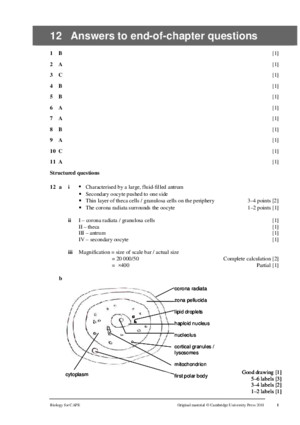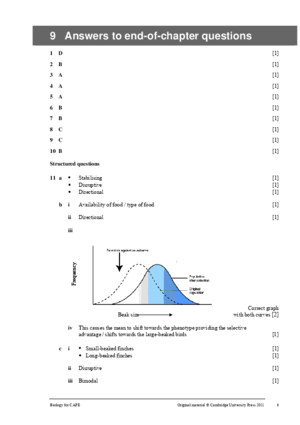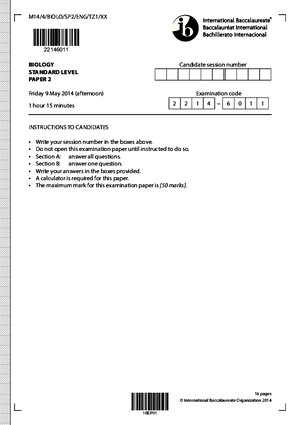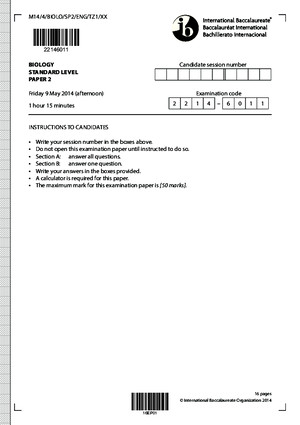Biology for CAPE Unit 1 Chapter 11 Answers
There is document - Biology for CAPE Unit 1 Chapter 11 Answers available here for reading and downloading. Use the download button below or simple online reader.
The file extension - PDF and ranks to the School Work category.
Tags
Related
Comments
Log in to leave a message!
Description
Download Biology for CAPE Unit 1 Chapter 11 Answers
Transcripts
Biology for CAPE Original material © Cambridge University Press 2011 1 11 Answers to end-of-chapter questions 1 C [1] 2 B [1] 3 B [1] 4 C [1] 5 C [1] 6 B [1] 7 C [1] 8 D [1] 9 C [1] 10 C [1] Structured questions 11 a I – fibrous layer II – vascular bundle III – tapetum IV – filament V – inner layer of fibrous layer 2 labels [1] VI – pollen mother cells / developing pollen grains [max 3] b Length of scale bar = 6 mm Therefore 6 mm = 200 μ m Length from A to B = 104 mm Complete calculation [1] Actual length = 104/6 × 200 = 3467 μ m Partial [1] c • Pollen mother cells undergo meiosis • Each produces a tetrad of 4 haploid cells • Cells absorb nutrients from tapetum • Cells increase size • Secretion of exine / outer walls • Pollen grains separate • Nucleus of each pollen grain divides by mitosis • Produces generative and pollen tube nuclei Every 2 points [1] • Exine complete their development [max 4] d Meiosis occurs • Produces gametes which contain haploid number of chromosomes • This is important because in sexual reproduction fertilisation of gametes occurs • This allows for restoring of chromosome number / maintenance of a constant chromosome number / meiosis allows the chromosome number to remain constant in each generation 3–4 points [2] • Crossing over leads to genetic variation 1–2 points [1] e Biology for CAPE Original material © Cambridge University Press 2011 2 Well drawn [2] Labels [2] 12 a I – pollen tube II – locule III – nucellus IV – antipodal cells V – primary endosperm nucleus VI – egg cell 8–9 points [4] VII – synergids 6–7 points [3] VIII – funicle 4–5 points [2] IX – placenta 2–3 points [1] b Each point [1] c • Both serve as attachment points • VIII attaches ovule to ovary wall / IX attaches ovary to rest of plant Any point [1] d • Haploid nucleus of pollen grain divides by mitosis • Produces 2 nuclei – generative and pollen tube (B) • The generative nucleus then divides by mitosis to give 2 male 4 points [3] gametes (A) 3 points [2] • Both A and B are haploid 2 points [1] e Micropyle allows pollen tube to enter the ovule so fertilisation can take place [1] f • C / ovary becomes the fruit [1] • D / integuments become the testa [1] g See diagram above / should be through the locule, close to ovary wall Each point [1] ovule embryo sac Biology for CAPE Original material © Cambridge University Press 2011 3 13 a i Meiosis [1] ii • Three of the four cells / megaspores nearest the micropyle degenerate [1] • Leaving one megaspore to develop [1] iii Haploid ( n ) / one set of chromosomes [1] iv Mitosis occurs three times [1] v 3 antipodal 2 polar 4 points [3] 2 synergids 3 points [2] 1 egg nucleus 2 points [1] vi Generative [1] vii 2 male nuclei [1] 1 pollen tube nucleus [1] b • Separation of male and female plants / dioecious • Eg marijuana, pawpaw, chenet • Monoecious / separation of male and female flowers but on same plant • Eg castor oil, corn, pumpkin • Protandry / anthers mature before stigma • Eg rose-bay willow herb, fireweed • Protogyny / stigmas mature before anthers • Eg avocado, soursop • Self-incompatibility / if pollen grain with same allele as stigma, does not germinate • Eg tobacco, cabbage Any mechanism [1] • Heterostyly: specialised pollination structures, pin and thrum example [1] • Eg red cordial, primrose [max 4] Essay questions 14 a Self-pollination Asexual • meiosis occurs • mitosis occurs • some genetic variation in offspring / crossing over • genetically identical offspring / clones • produces gametes • no gametes produced • fertilisation • no fertilisation • produces seeds • no seeds produced • uses gametes / reproductive • uses vegetative structures to multiply Each comparison [1] [max 3] b i • Self-fertilisation • Since plants are widely scattered, would not be close to other plants to pollinate / pollinating agents scarce • No wastage of gametes • Plants would be well adapted to the environment • Can also be asexual
Recommended















